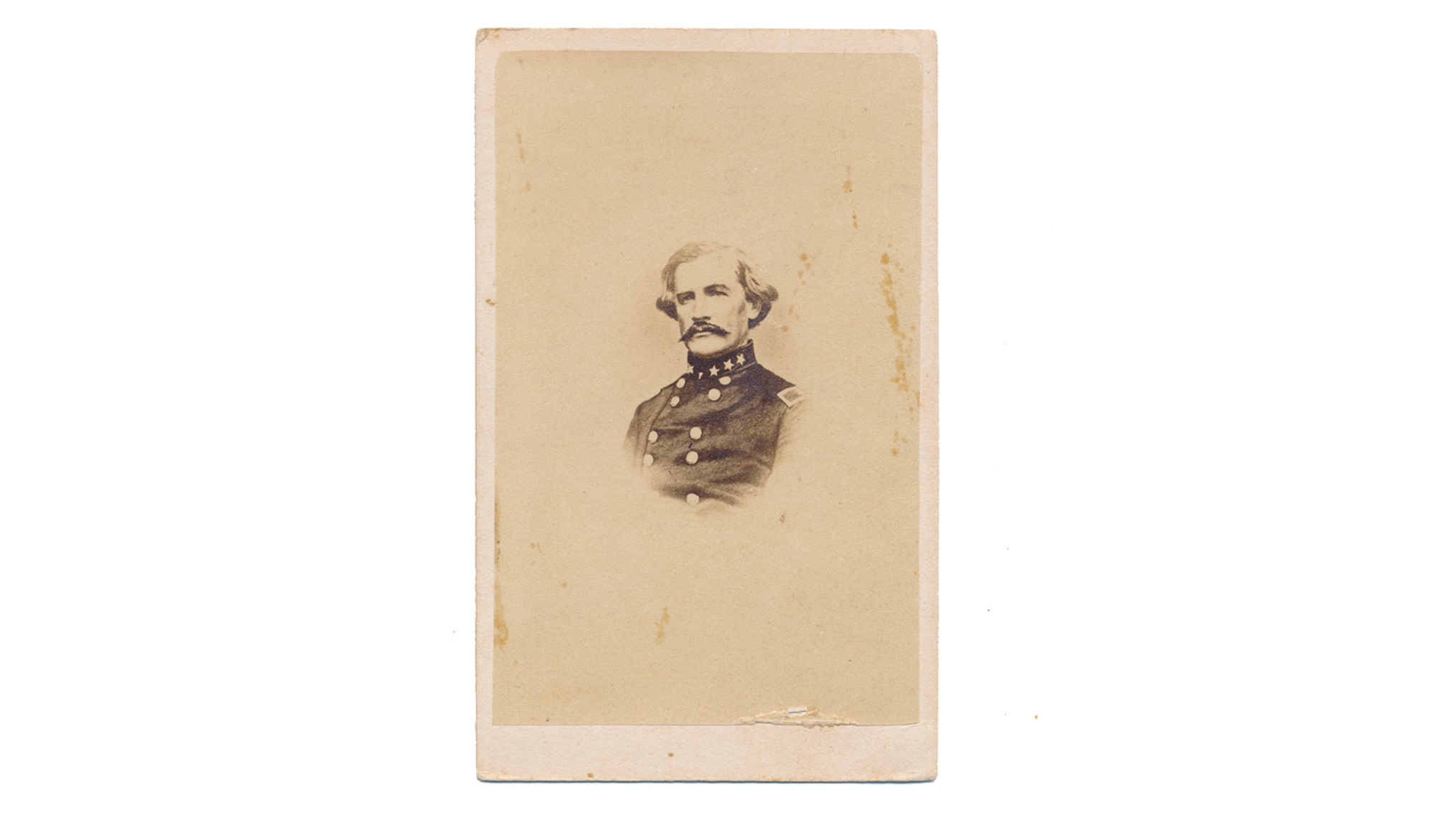site search
online catalog
BUST VIEW LITHOGRAPH OF CONFEDERATE GENERAL BENJAMIN F. CHEATHAM

$95.00 SOLD
Quantity Available: None
Item Code: 855-68
Image is a bust view of Cheatham in the uniform of a Confederate General Officer.
Image is clear overall but does get a little light near the top of the General’s head. Paper has some linear discolorations along the right edge and general surface dirt throughout.
Reverse is blank.
Benjamin Franklin Cheatham was born in Nashville, Tennessee on October 20, 1820 on a plantation of 3,000 acres called Westover. He was born into two of the finest and prominent families of the middle Tennessee elite of the slave society. His mother was descended from General James Robertson, the founder of Nashville and "father" of Middle Tennessee, who came from Virginia. The Cheathams had been in middle Tennessee for two generations and become established as plantation owners, lawyers, doctors and mayors of the city.
At the start of the Mexican War, Cheatham joined the 1st Tennessee Infantry Regiment as a Captain and finished the war having been promoted to Colonel of the 3rd Tennessee. He moved to California in 1849 for the Gold Rush, but returned to Tennessee in 1853 where he managed his plantation and served as a Brigadier General in the Tennessee Militia.
Cheatham joined the Confederate States Army as a Brigadier General on May 9, 1861, and became a brigade commander in the Western District of Department Number Two, under Maj. Gen. Leonidas Polk. His first test in the war was in Missouri on November 7 at the Battle of Belmont, leading three regiments in Brig. Gen. Gideon J. Pillow's division against Union Brig. Gen. Ulysses S. Grant, also in his first Civil War combat. In December, Cheatham and his division received the Thanks of Congress, "for the desperate courage they exhibited in sustaining for several hours, and under most disadvantageous circumstances an attack by a force of the enemy greatly superior to their own, both in numbers and appointments; and for the skill and gallantry by which they converted what at first threatened so much disaster, into a triumphant victory."
Cheatham was promoted to Major General, on March 10, 1862, and was appointed commander of the 2nd Division, First Corps, Army of Mississippi. He led his division at the Battle of Shiloh where he was wounded, at Perryville and Stones River. At the latter battle, Cheatham performed sluggishly, ordering piecemeal assaults; observers claimed he had been drinking heavily and was unable to command his units effectively.
Cheatham continued as a division commander under Bragg at the Battle of Chickamauga and Chattanooga, including Missionary Ridge, where Bragg was defeated by Grant.
In 1864, Cheatham fought well in the Atlanta Campaign under General Joseph E. Johnston, and later Lt. Gen. John Bell Hood, inflicting heavy casualties on William T. Sherman's Union Army at the Battle of Kennesaw Mountain, and was wounded at the Battle of Ezra Church. He took over command of Hood's corps when Hood was elevated to command the army on July 18, and led his corps in the battles around Atlanta.
Cheatham's most famous service came as a corps commander under Hood in the Franklin-Nashville Campaign. He was engaged in all the major battles of the campaign, receiving notoriety when the Union Army under Maj. Gen. John M. Schofield was able to slip by him and escape from the Battle of Spring Hill, which foiled Hood's plan and led to the disastrous Confederate defeat at Franklin the next day. Hood accused Cheatham of dereliction of duty and the enmity between them lasted for the rest of their lives. After the collapse of Hood's army at Nashville, Cheatham joined Johnston's motley command for the Carolinas Campaign as a division commander, the highest position this small army could justify. He surrendered to General Sherman in North Carolina in April 1865.
Shortly after the war he married for the first time to Anna Bell Robertson of North Carolina. They had five children together. Their son Benjamin Franklin Cheatham, Jr. (1867–1944) was a Major General in the U.S. Army, serving with distinction in the Spanish–American War and World War I.
After the war, Cheatham declined an offer of Federal civil service employment from President Grant. He was an unsuccessful candidate for the United States House of Representatives in 1872 and served for four years as the appointed superintendent of a Tennessee state prison. He was appointed postmaster of Nashville (1885–1886).
He died in Nashville and is buried there in Mount Olivet Cemetery.
~~~~~~~~~~~~~~~~~~~~~~~~~~~~~~~~~~~~~
THIS ITEM, AS WITH ALL OTHER ITEMS AVAILABLE ON OUR WEB SITE,
MAY BE PURCHASED THROUGH OUR LAYAWAY PROGRAM.
FOR OUR POLICIES AND TERMS,
CLICK ON ‘CONTACT US’ AT THE TOP OF ANY PAGE ON THE SITE,
THEN ON ‘LAYAWAY POLICY’.
THANK YOU!
Inquire About BUST VIEW LITHOGRAPH OF CONFEDERATE GENERAL BENJAMIN F. CHEATHAM
For inquiries, please email us at [email protected]
Most Popular
Historical Firearms Stolen From The National Civil War Museum In Harrisburg, Pa »
Theft From Gravesite Of Gen. John Reynolds »
Cavalry Carbine Sling Swivel »
Fine Condition Brass Infantry Bugle Insignia »
featured item
AMBROTYPE OF IDENTIFIED MUSICIAN OF THE PETERSBURG MILITIA
Formerly in the collection of Bill Turner, this sixth plate ambrotype has a great pedigree, having been published as Figure 2 in Albaugh’s landmark “Confederate Faces.” Identified there as a, “Musician named Crowder, of Petersburg, Va., in… (1138-1866). Learn More »



